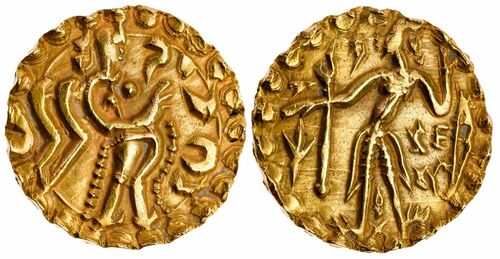
Auction: 23109 - Spink Numismatic e-Circular 29: Indian and Islamic Coins Featuring 'A Gentleman's Collection of Sri Lankan Coins' Part II - e-Auction
Lot: 8180
(x) Ancient India, Post-Gupta Bengal, Samatata region, "Sri Raja Bhata" (c.675- 680), gold Dinar, 5.64g, kingly figure standing left holding a bow right and an arrow left, a standard topped by a conch shell in left field, Brahmi letter sri above, trisul far left, Brahmi legend ra ja bha ta in right field, rev. stylized female figure wearing cloak standing right, pseudo legend in right field (Group J2, N. Rhodes (ed. W. Bertsch), "The Coinage of Samatata", JONS 228, Summer 2016, pp.9-15), about uncirculated, as struck, rare
After the fall of the Gupta Empire in the 6th century, the history of Bengal is unclear. It is only relatively recently that gold coins of this type have been found in south eastern Bengal, in the area covered by ancient Samatata. Their design is clearly derived from that of the Guptas (or earlier Kushans), with a standing kingly figure on the obverse and a deity or goddess on the reverse. Some of them bear legends in the right field of the obverse that may shed light on the early history of Samatata. In the case of this coin the name "Sri Raja Bhata" is also found on local copper plate inscriptions. Also the Chinese Buddhist pilgrim Seng-che mentions him before 685.
The references in this listing are taken from a posthumous paper by Nicholas Rhodes, "The Coinage of Samatata" edited by Wolfgang Bertsch, published in the Journal of the Oriental Numismatic Society #228, Summer 2016 https://www.orientalnumismaticsociety.org/archive/ONS_228.pdf#page=15
Subject to 5% tax on Hammer Price in addition to 20% VAT on Buyer’s Premium.
Estimate
£1,000 to £1,300
Starting price
£900




